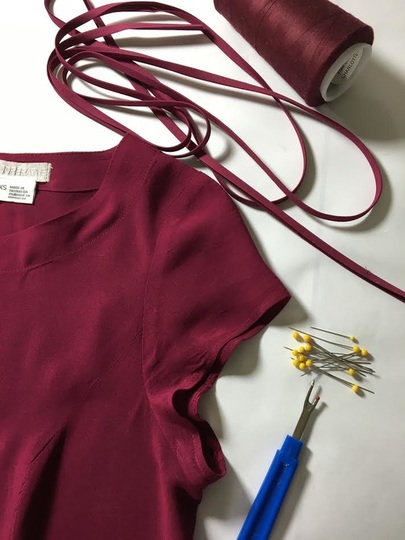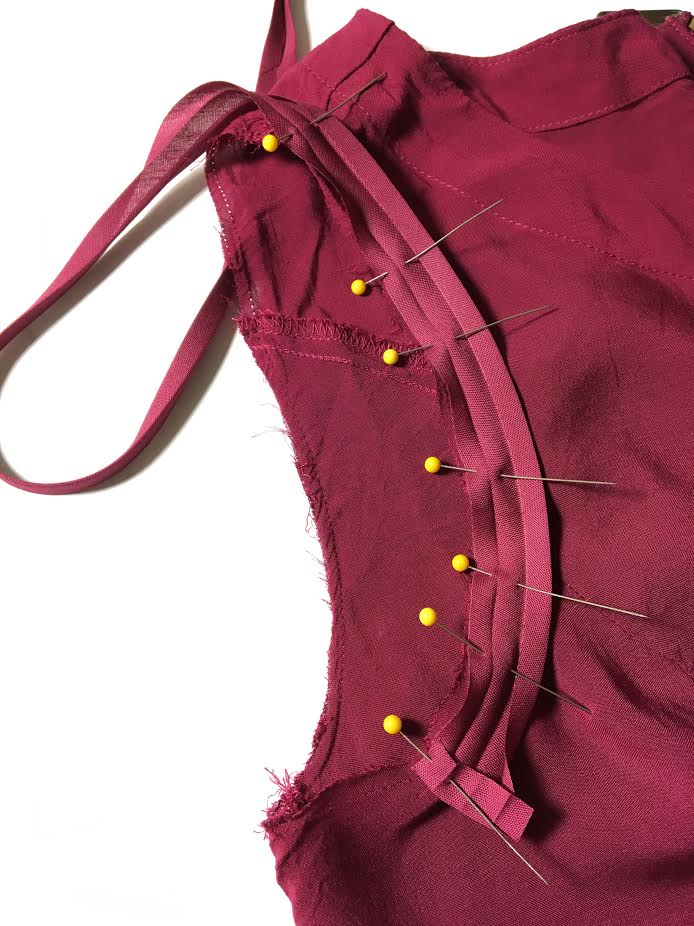 Have you ever looked at one of your dresses or blouses and thought: I really wish this was sleeveless… Perhaps the sleeves feel uncomfortable, or maybe they don’t lay or fit the way you would like them to. Sleeve styles can be a great representation of past and present fashion trends, which sometimes risks making a clothing item look and feel outdated once trends change and evolve. For example, the transition from over-sized, puffy sleeves in the 80's and 90's to plain sleeves in later years is probably the most recognizable in sleeve-trends. Like most of us, you or someone in your family is probably still holding on to some outdated sleeve styles somewhere in the back of their closet. It so happens that when we really love a clothing item, it is kind of difficult to let it go even if we might never wear it again. If the rest of the garment is perfect but the sleeves are a deal breaker, the good news is, you can always remove them! If you own a sewing machine and have played around with sewing and crafts a bit, this shouldn’t be too difficult. We’ll show you how! Step 1: Remove the existing sleeves Turn your dress or blouse inside out and using your trusty seam-ripper, remove the stitching around the armhole. You will notice that the raw edges of your armhole seam are clean-finished most likely with an overlock stitch as shown bellow. You will also need to remove this overlock/serging stitch in order to separate the sleeve from the garment. Overlock/serging stitches take a bit longer to remove but there is definitely a trick to it. Learn the easiest way to do it by following the steps for removing a serging/overlock stitch in last week's blog post. Using your seam-ripper, cut through the straight stitch and pull on the thread to remove it. Depending on how long the stitch is, you can rip through one stitch loop every two or three inches. If the stitch is longer and comes out very easily, you can always increase the increments for ripping the stitch loops, then pull the end of the threads to remove. Repeat for removing the second sleeve. Step 2: Pin the binding to the raw edge Although there are a few different ways to clean finish the armholes, using pre-cut and pre-folded binding is probably the easiest. You can buy pre-folded binding at your local fabric store. Make sure you get the version that say "double fold" on the label. This means that the binding is folded three times and designed to enclose the raw edges. Usually, 1/4" wide binding is most appropriate for the armhole because the smaller width makes it easier to maneuver when sewing along round edges. 1. Turn your dress or blouse on its face side (you should be pinning your binding to the face of the garment). Begin by folding one of the ends of your binding in about 1/4" as shown in the image above. Pin the binding with the inside of the fold facing up making sure the edge of the binding is perfectly aligned to the raw edge of the armhole. The face of your garment's fabric should be touching with the outside of the binding. 2. Continue pining horizontally around the edge of the armhole until you reach the initial fold you started with. Overlap the binding and cut the edge as shown above. The binding edges should be overlapping so that when you sew, the raw edges of both the armhole and the binding are enclosed by the 1/4" binding fold you started with. Repeat on the second armhole. Step 3: Sew the binding Sewing the binding can sometimes take a little bit of practice so if you're somewhat of a beginner you should tread carefully. Don't forget that if you make a wrong turn, you can always use your seam-ripper to undo the stitching! Attaching the binding is comprised of three steps: sewing the outer edges together, folding in twice to enclose the raw edges and hide the binding on the inside (ironing as you fold),and finishing the binding with a stitch along the inner fold. We'll show you these detailed steps bellow! 1. Stitch on top of the fold that is closest to the raw edges using the fold line as a guide. Be very careful to keep the edges of the armhole and the binding aligned at all times. This can get a little challenging when you get to the rounder parts of the armhole but if you move a little slower around those edges, you'll be just fine. Once you get to where you started stitching, overlap the stitches and back-stitch to keep in place, ensuring a durable finish. Read more about back-stitching in the how to back-stitch by hand or on the machine blog. 2. Using the pre-fold of your binding as a guide, fold the binding in once to enclose the raw edges, then fold once more to hide the binding on the inside of the garment. Iron as you fold and place a few pins to keep this fold in place. The outside of your armhole should be clean and the binding should only be visible on the inside. Repeat for the the second armhole. 3. Stitch on the inside of the garment, using the inner-most fold of the binding as a guide. Stitch as close to the fold as possible maintaining a steady, straight stitch all around. Pictured above is what your armholes should look like once finished. For a clean, professional look make sure you iron down the edges of the completed armholes on the face side of your dress or blouse.
1 Comment
|
The Blog:A journey into our design process, sewing tutorials, fashion tips, and all the inspiring people and things we love. Doina AlexeiDesigner by trade and dressmaker at heart. I spend most of my days obsessing over new fabrics and daydreaming new ideas. Sadie
Executive Assistant & Client Relations Manager Archives
November 2019
Categories
All
|
-
Sewing Tutorials
-
Basics
>
- Aligning Pattern Grainlines To Fabric
- Preparing Fabrics For Sewing
- Pinning Sewing Patterns To Fabric
- Placing Sewing Patterns On Fabric For Cutting
- Rotary Cutters or Fabric Scissors?
- Cutting The Sewing Patterns
- What Are Notches And How To Use Them In The Sewing Process
- Transferring Notches From Pattern To Fabric
- Transferring Seamlines to Fabric
- Staystitching
- Backstitching: A Complete Guide
- Hand Basting: A Complete Guide
- Sewing Continuous Bias Binding
- Darts >
-
Sewing Seams
>
- The Basics Of Seams And Seam Allowance
- How To Sew A Straight Seam
- Sewing Curved Seams
- Sewing Corner Seams
- Trimming And Grading Seam Excess
- Notching/Clipping Seam Allowance for Tension Release
- Sewing Topstitched Seams
- Sewing Corded Seams
- Sewing A Slot Seam
- Sewing A Gathered Seam
- Sewing Bias Seams
- Sewing Seams With Ease
- Sewing Seams With Crossing Seamlines
- Sewing Unlike Fabric Seams
- How To Iron Seams: Ironing Tools And Conventions
- Sewing With Knit Fabrics
- Understanding Stitch Length And Tension
- Sewing Unique Fabric Seams
-
Seam Finishes
>
- Seam Finishing Techniques - Overview
- Applying A Pinked Seam Finish
- Applying A Bias Bound Seam Finish
- Serging And Zigzag Seam Finishes
- Sewing A Self-Bound Seam Finish
- Sewing A French Seam Finish
- Sewing A Hong Kong Seam Finish
- Sewing A Mock French Seam Finish
- Sewing A Turned-and-Stitched Seam Finish
- Sewing Overcast Hand-Applied Seam Finishes
- Sewing A Flat Felled Seam
- Sewing A Hairline Seam Finish
-
Hem Finishes
>
- Garment Hem Finishes: Overview
- Sewing A Double Fold Hem Finish
- Sewing A Single Fold Hem Finish
- Sewing Bound Hem Finishes
- Sewing An Exposed Double Layer Bound Hem
- Sewing A Folded-Up Bound Hem with Pre-folded Binding
- Sewing A Hong Kong Hem Finish
- Sewing A Band Hem Finish
- Sewing A Bias Faced Hem Finish
- Sewing A Twill Tape Hem Finish
- Sewing A Rolled Hem Finish
- Sewing A Shaped Hem Facing
- Using Fusible Hem Tape And Webbing
- Finishing A Lace Fabric Hem
- Finishing A Leather Hem
- Sewing Faced Hem Corners
- How To Finish Lining At The Hem
- Finishing Fabric Corners by Mitering >
- Interfacing A Hemline: Lined And Unlined Examples
-
Sewing Pockets
>
- Curved Patch Pocket With Flap
- Unlined Square Patch Pockets
- Lined Patch Pockets: Two Ways
- Extension On-Seam Pockets
- Separate On-Seam Pocket
- Front Hip Pockets
- Bound Double Welt Pocket
- Double Welt Pocket With Flap
- Self-Welt Pocket (Using Single Fabric Layer)
- Slanted Welt Pocket (Hand-Stitched)
- Faced Slash Pockets: Overview >
-
Sewing Zippers
>
- Sewing Zippers: General Information
- Sewing A Centered Zipper
- Sewing A Lapped Zipper
- Sewing An Invisible Zipper
- Sewing A Fly Front Zipper
- Sewing A Closed-End Exposed Zipper (No Seam)
- Sewing An Exposed Separating Zipper
- Sewing Hand Stitched Zipper Applications
- Sewing A Zipper Underlay
- Sewing A Placket-Enclosed Separating Zipper
- Sleeveless Finishes >
-
Neckline Finishes
>
- Sewing A Neck Shaped Facing
- Sewing An All-In-One Neck Facing
- Neck And Garment Opening Combination Facings >
- Sewing A Bias Faced Neckline Finish
- Sewing A Band Neckline Finish
- Bound Neckline Finishes: Overview >
- Sewing A Semi-Stretch Strip Band Neckline
- Ribbed Neck Band And Classic Turtleneck
- Decorative Neckline Finishes >
- Finishing Facing Edges >
-
Extras
>
- A Complete Guide on Interfacing
- Sewing Bound Spaghetti Straps
- Sewing Spaghetti Straps To A Faced Neckline
- Sewing Ruffles: Overview
- Patterning And Sewing A Circle Ruffle
- Sewing A Gathered Heading Ruffle
- Sewing Double Layer Gathered Ruffles
- Sewing A Gathered Ruffle Into A Seam
- Sewing A Gathered Ruffle To A Fabric Edge
- Sewing A Fabric Surface Slit
- Sewing A Slit Seam
- Hand-Applied Straight Stitches
- Hand-Applied Blind Stitches
- Hand-Applied Overedge Stitches
- Hand-Applied Tack Stitches
- Hand-Applied Decorative Stitches
-
Basics
>
- Custom Bridal
- Custom Apparel
- About
- Blog
Services |
Company |
|
















 RSS Feed
RSS Feed

